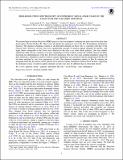| dc.contributor.author | Simon, Joshua D. | |
| dc.contributor.author | Geha, Marla | |
| dc.contributor.author | Ji, Alexander Pung | |
| dc.contributor.author | Frebel, Anna L. | |
| dc.date.accessioned | 2016-05-24T13:03:00Z | |
| dc.date.available | 2016-05-24T13:03:00Z | |
| dc.date.issued | 2016-01 | |
| dc.date.submitted | 2015-10 | |
| dc.identifier.issn | 1538-4357 | |
| dc.identifier.issn | 0004-637X | |
| dc.identifier.uri | http://hdl.handle.net/1721.1/102650 | |
| dc.description.abstract | We present high-resolution Magellan/MIKE spectra of the four brightest confirmed red giant stars in the ultra-faint dwarf galaxy Bootes II (Boo II). These stars all inhabit the metal-poor tail of the Boo II metallicity distribution function. The chemical abundance pattern of all detectable elements in these stars is consistent with that of the Galactic halo. However, all four stars have undetectable amounts of neutron-capture elements Sr and Ba, with upper limits comparable to the lowest ever detected in the halo or in other dwarf galaxies. One star exhibits significant radial velocity variations over time, suggesting it to be in a binary system. Its variable velocity has likely increased past determinations of the Boo II velocity dispersion. Our four stars span a limited metallicity range, but their enhanced α-abundances and low neutron-capture abundances are consistent with the interpretation that Boo II has been enriched by very few generations of stars. The chemical abundance pattern in Boo II confirms the emerging trend that the faintest dwarf galaxies have neutron-capture abundances distinct from the halo, suggesting the dominant source of neutron-capture elements in halo stars may be different than in ultra-faint dwarfs. | en_US |
| dc.description.sponsorship | National Science Foundation (U.S.) (CAREER Grant AST-1255160) | en_US |
| dc.language.iso | en_US | |
| dc.publisher | IOP Publishing | en_US |
| dc.relation.isversionof | http://dx.doi.org/10.3847/0004-637X/817/1/41 | en_US |
| dc.rights | Article is made available in accordance with the publisher's policy and may be subject to US copyright law. Please refer to the publisher's site for terms of use. | en_US |
| dc.source | IOP Publishing | en_US |
| dc.title | HIGH-RESOLUTION SPECTROSCOPY OF EXTREMELY METAL-POOR STARS IN THE LEAST EVOLVED GALAXIES: BOOTES II | en_US |
| dc.type | Article | en_US |
| dc.identifier.citation | Ji, Alexander P., Anna Frebel, Joshua D. Simon, and Marla Geha. “HIGH-RESOLUTION SPECTROSCOPY OF EXTREMELY METAL-POOR STARS IN THE LEAST EVOLVED GALAXIES: BOOTES II.” The Astrophysical Journal 817, no. 1 (January 20, 2016): 41. © 2016 The American Astronomical Society | en_US |
| dc.contributor.department | Massachusetts Institute of Technology. Department of Physics | en_US |
| dc.contributor.department | MIT Kavli Institute for Astrophysics and Space Research | en_US |
| dc.contributor.mitauthor | Ji, Alexander Pung | en_US |
| dc.contributor.mitauthor | Frebel, Anna L. | en_US |
| dc.relation.journal | The Astrophysical Journal | en_US |
| dc.eprint.version | Final published version | en_US |
| dc.type.uri | http://purl.org/eprint/type/JournalArticle | en_US |
| eprint.status | http://purl.org/eprint/status/PeerReviewed | en_US |
| dspace.orderedauthors | Ji, Alexander P.; Frebel, Anna; Simon, Joshua D.; Geha, Marla | en_US |
| dspace.embargo.terms | N | en_US |
| dc.identifier.orcid | https://orcid.org/0000-0002-4863-8842 | |
| dc.identifier.orcid | https://orcid.org/0000-0002-2139-7145 | |
| mit.license | PUBLISHER_POLICY | en_US |
